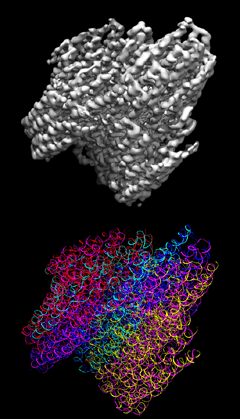Increasingly, origami (the Japanese art of paper folding) is becoming less of an artistic concern and more of a scientific one. The California Institute of Technology made special news in 2006 about a way to weave DNA strands into any two-dimensional shape or figure. Caltech’s Paul Rothemund called it “DNA origami” — but that was just the start of it.

Imagine strands of DNA folded back and forth, forming a scaffold that fills the outline of a desired shape. Then, imagine more DNA strands specially designed to bind to that scaffold.
Rothemund, the strand-weaver, explained why this was useful. Scientists would find it easy to create and study any complex nanostructures they might want. Quoted in a 2006 press release, in he said he came up with a half a dozen shapes, including square, triangle, five-pointed star, and smiley face.
“At this point, high-school students could use the design program to create whatever shape they desired,” Rothemund said at the time.
Nature News said the binders, DNA ‘staples,’ were short strands “that stop the viral strand from unraveling,” adding that the method could find use in molecular biology and electronics. “The technique could be used to build a flat scaffold to carry microscopic electronic components. Enzymes could also be attached, creating a tiny protein factory,” the article emphasized.
In 2016, Caltech shed new light on the discovery. “The publication of Paul Rothemund’s paper on DNA origami (Nature, March 16, 2006) marked a turning point in DNA nanotechnology, enabling unprecedented control over designed molecular structures.”
Step by step

Well, it’s 2021 and better late than never. The latest news about DNA origami is that Jacob Majikes and Alex Liddle, researchers at the National Institute of Standards and Technology (NIST), having stayed with the topic of DNA origami for years, have compiled a detailed tutorial on the technique. “DNA Origami Design: A How-To Tutorial” has been published in the Journal of Research of the National Institute of Standards and Technology. Majikes and Liddle have provided a step-by-step guide on the design of DNA origami nanostructures, making it easier than ever to design and use this type of structure.
Over the years, the method had attracted hundreds of researchers, said NIST, and for various reasons: Some may be interested in order to detect and treat diseases, or, to assess pollutants’ impacts on the environment and other applications. The two guide authors explained what they did. Namely, they went for the ‘how.’
“We wanted to take all the tools that people have developed and put them all in one place, and to explain things that you can’t say in a traditional journal article,” said Majikes. “Review papers might tell you everything that everyone’s done, but they don’t tell you how the people did it.”
Their journal paper further stated what was needed:
“While the design and assembly of DNA origami are straightforward, its relative novelty as a nanofabrication technique means that the tools and methods for designing new structures have not been codified as well as they have for more mature technologies, such as integrated circuits. While design approaches cannot be truly formalized until design-property relationships are fully understood, this document attempts to provide a step-by-step guide to designing DNA origami nanostructures using the tools available at the current state of the art.”
Many potential applications of DNA origami have been suggested in literature, including drug delivery systems and nanotechnological self-assembly of materials, so this is not just some ethereal approach, it has clinical use. For instance, Harvard University Wyss Institute researchers reported the self-assembling and self-destructing drug delivery vessels using the DNA origami in lab tests, and another team of researchers from China and the US created a DNA origami delivery vehicle for Doxorubicin, a commonly used anti-cancer drug. So when someone acts like origami is just cute art, tell them that’s not nearly the case — it could be a real lifesaver.






